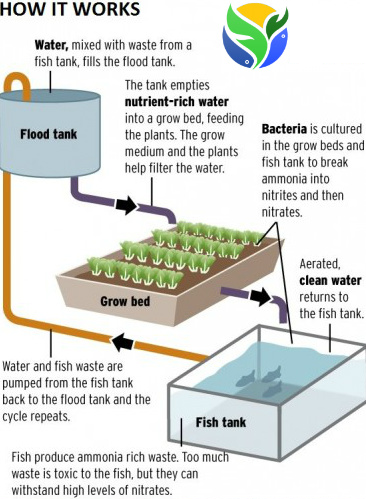Are you wondering “what is Aquaponics?” The most simple definition is that it is the marriage of aquaculture (raising fish) and hydroponics (the soil-less growing of plants) that grows fish and plants together in one integrated system. The fish waste provides natural food source for the growing plants and the plants provide a natural filter for the water the fish live in. The third participants are the microbes (nitrifying bacteria) and composting red worms that thrive in the growing media. They do the job of converting the ammonia from the fish waste first into nitrites, then into nitrates and the solids into vermicompost that that are food for the plants. In combining both systems aquaponics capitalizes on the benefits and eliminates the drawbacks of each.
The problems with traditional soil-based gardening
- The weeds
- The amount of water required
- The soil-borne insects
- The heavy digging, the bending, the back strain
- Knowledge required to know when to water, when and how to fertilize, and what is the composition of the soil
These issues are all solved with hydroponics, but hydroponics has problems of its own
- Traditional hydroponic systems rely on the careful application of expensive, man-made nutrients made from mixing together a concoction of chemicals, salts and trace elements. In aquaponics you merely feed your fish inexpensive fish feed, food scraps, and food you grow yourself.
- The strength of this mixture needs to be carefully monitored, along with pH, using expensive meters. In aquaponics you carefully monitor your system during the first month, but once your system is established you only need to check pH and ammonia levels occassionally or if your plants or fish seem stressed.
- Water in hydroponic systems needs to be discharged periodically, as the salts and chemicals build up in the water which becomes toxic to the plants. This is both inconvenient and problematic as the disposal location of this waste water needs to be carefully considered. In aquaponics you NEVER replace your water; you only top it off as it evaporates.
- Hydroponic systems are prone to a disease called “pythium” or root rot. This disease is virtually non-existant in aquaponics.
And Aquaponics is proven to be even more productive than hydroponics!
The problem with recirculating aquaculture
- The tank water becomes polluted with fish effluent which gives off high concentrations of ammonia. Water has to be discharged at a rate of 10-20% of the total volume in the tank daily. This uses a tremendous amount of water. Again, in an aquaponics system you never need to discharge your water
- This water is often pumped into open streams where it pollutes and destroys waterways.
- Because of this unhealthy environment fish are prone to disease and are often treated with medicines, including antibiotics. Fish disease is rare in an aquaponics system.
How aquaponics changes the game
- Waist-high aquaponics gardening eliminates weeds, back strain and animal access to your garden.
- Reuse resources currently considered “waste”. In aquaponics there is no more toxic run-off from either hydroponics or aquaculture.
- Aquaponics uses only 1/10th of the water of soil-based gardening, and even less water than hydroponics or recirculating aquaculture.
- Watering is integral to an aquaponics system. You can’t under-water or over-water.
- Fertilizing is also integral to an aquaponics system. You can’t over-fertilize or under-fertilize.
- Gardening chores are cut down dramatically or eliminated. The aquaponics grower only does the enjoyable tasks of feeding the fish and tending and harvesting the plants.
Instead of using dirt or toxic chemical solutions to grow plants, aquaponics uses highly nutritious fish effluent that contains all the required nutrients for optimum plant growth. Instead of discharging water, aquaponics uses the plants and the media in which they grow to clean and purify the water, after which it is returned to the fish tank. This water can be reused indefinitely and will only need to be replaced when it is lost through transpiration and evaporation. Two primary methods of aquaponics growing are most widely in use today.

